
Future Projections: Cell Phone Market Poised for Projectors
The market for tiny handheld projectors,
known as pico projectors, began in earnest a few years ago, with companies like
Microvision Inc., Explay and 3M introducing prototypes at industry events such as
the 2008 Consumer Electronics Show (CES). Shortly after, industry wags began writing
that consumers would soon be able to buy cell phones and other electronic devices
containing embedded projectors, but that has yet to happen in a significant way.
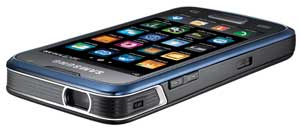
Samsung’s Galaxy Beam smart phone is the first phone on the market to feature an embedded
projector. It hit the marketplace in July, but it is currently available only in
Singapore. Courtesy of Samsung.
A number of those early products, although garnering a fair share
of press, were considered by some in the industry to be more like beta launches
than actual market-ready product debuts because of the amount of power they used
and their unsatisfactory image quality, to name but a couple of their drawbacks.
The pocket projector market surged from 10 models in 2008 to more
than 130 in 2009, but “most of the designs are still quite boring,”
said Dr. Jennifer Colegrove, director of display technologies for DisplaySearch,
who presented a market overview in May 2010 during the Society for Information Display
(SID)’s Display Week in Seattle.
Perhaps in a rush to take advantage of industry buzz, some took
off-the-shelf technology, added memory and put it into a small package and called
it a pico projector, but they hadn’t yet solved issues such as connectivity
to a host device, resulting in a “spaghetti factory” of wires and cables
to achieve a projected image, said Matt Nichols, director of communications for
Redmond, Wash.-based Microvision, which markets its own laser-based pico projector,
the SHOWWX.
“What the market didn’t take into consideration is
that just because you can project, it doesn’t mean you should,” Nichols
said.
By the time CES was held in January 2010, several companies demonstrated
prototypes of cell phones with projectors, although not necessarily embedded ones.
“Everybody was kind of chasing the accessory space because
of price, performance, size and power requirements. No one had a solution for a
mobile phone,” he said.
The pico projector on LG Electronics’ eXpo – which
contains Texas Instruments’ (TI) digital light processing (DLP) chip –
clips onto the back of the phone and is sold separately for a retail price of about
$180. The eXpo was announced in December 2009 and featured at CES 2010 but soon
began shipping without the projector. A number of technology websites reported in
March that the projector accessory was delayed by production problems, while the
company attributed the dearth of units to “strong demand.”
“LG created a full-blown ad campaign, and nobody on the
planet could buy it,” Nichols said.
At press time, the handset was listed as “out of stock”
on provider AT&T’s website.
Samsung’s Galaxy Beam, the first smart phone with an embedded
projector (also courtesy of TI’s DLP chip), was officially unveiled at the
February 2010 Mobile World Congress in Barcelona, Spain, and hit the marketplace
in July, but it is currently available only in Singapore, through mobile service
provider StarHub.
So what is hampering industry efforts to embed pico projectors
into phones? One key drawback is the lack of a true green (515- to 535-nm) laser
diode that can cost-effectively be produced in the vast quantities needed for the
cell phone market. Shrinking light sources in such electronics is critical because
today’s mass market consumer expects the latest cell phone to be thin, sleek
and fashionable and not look “like it resembles one from 1995,” Nichols
said.
With direct-diode green lasers, “not only does size get
smaller, but performance increases, the price goes down, and you can push resolution
to HD-ready 720p levels,” he added.
Closing the green gap
Lasers are seen as an ideal light-emitting device for pico projectors
because of their wide color gamut, brightness and focus-free operation, although
speckle noise – black dots that make the image appear grainy – is a
problem, as is cost. Laser beam steering or microdisplay spatial light modulators
are the two options that pico projectors have for using laser light.
Red and blue lasers have been commercially available for years
and are produced in vast quantities on a monthly basis for applications such as
Blu-ray and CD players, but while red diodes, as the most mature, are extremely
cheap, blue diodes are still seen as fairly expensive, and green, even more so.
Although several companies say they have demonstrated direct-diode
green lasers in the lab, there currently are none available for the pico projector
market. Synthetic green lasers used today in portable electronic devices convert
infrared light from red lasers into green light via a frequency-doubling crystal,
a process that makes the laser more bulky and less efficient than direct-emitting
lasers.
Kaai Inc. of Goleta, Calif., created a buzz when it announced
in January that it had demonstrated a 523-nm continuous-wave green laser diode.
Kaai’s lasers are based on InGaN (indium gallium nitride) semiconductor technology
and fabricated on nonpolar and semipolar GaN substrates.
GaN semiconductors are available on the market for blue LEDs and
are a key material for pushing light-emitting devices into the green wavelength.
A big drawback to using the material in light emission is that luminance efficiency
drops quickly as the wavelength increases.
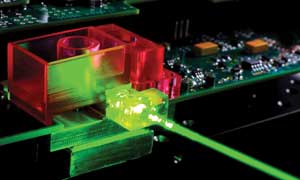
Courtesy of Corning Inc.
Sumitomo Electric Industries Ltd. of Osaka, Japan, announced in
July 2009 that it had solved that problem by developing a GaN crystal that inhibits
the efficiency drop, resulting in room-temperature pulse operation of a laser diode
emitting in the pure-green region of 531 nm.
Another hitch in the road to market for embedded projectors is
that, although frequency-doubled synthetic green lasers are more mature, supplies
have been far from plentiful. Microvision had to delay market rollout of the SHOWWX
because of laser supply constraints. The company has multiyear deals with Corning
Inc. of Corning, N.Y., and Osram Opto Semiconductors GmbH of Regensburg, Germany,
to supply their green and blue laser diodes, and says deliveries have improved.
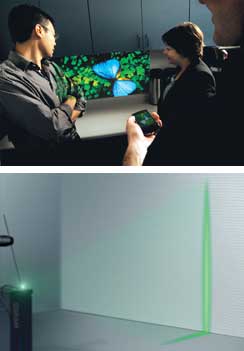
Top right: Lasers, such as Corning’s G-2000, are seen as ideal light-emitting devices for pico projectors because of their ability to provide a wide color gamut, high brightness and focus-free
operation. Courtesy of Corning Inc. Bottom right: With its direct-emitting green laser achievement in the lab, Osram Opto Semiconductors said it has set an important new milestone in mobile laser projection. Courtesy of Osram.
“For the short term, we’re now satisfied. A year ago
or six months ago, I would have said no,” Nichols said.
Corning promoted its latest green laser for microprojection, the
G-2000, at SID’s Display Week. The laser uses a 1060-nm distributed Bragg
reflector laser source to produce a green wavelength of 530 nm via a periodically
poled lithium niobate crystal waveguide.
The 720-pixel higher-brightness (15-lm output) prototype pico
projector that Microvision demonstrated at SID Display Week features the G-2000
and is scheduled to hit the market as a commercial product in the second half of
2011. The package size of this second-generation module is 25 percent smaller than
the first generation, Nichols said.
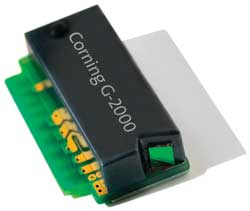
Corning’s G-2000 green laser is a high-quality, compact and efficient green light source for
use in embedded microprojectors.
“The module in the SHOWWX is a physical size that’s
acceptable to handset manufacturers. What isn’t acceptable is the price and
power performance,” he said. Manufacturers are now developing prototypes with
the current module.
Market requirements for green
The green laser is responsible for more than half of the projected
light from a red-green-blue (RGB) optical engine, so it must have enough optical
power to project displays at more than 15 lm. It also must have a high enough modulation
speed to project high-resolution (WVGA and above) images. Power efficiency, thermal
stability and size are other factors. Corning says that the G-2000 meets those requirements
by providing 80 mW of power, a wall-plug efficiency of 8 percent, modulation speeds
up to 150 MHz, an operating temperature range of 10 to 60 °C and a footprint
of less than 5 mm.
Other alternatives on the market to TI’s DLP chip, which
has an RGB LED as its light source, are pico projectors that use field-sequential
liquid crystal on silicon (LCoS) technology, and still others that use microelectromechanical
systems. In most of these systems, the technology can use either RGB LEDs or lasers
as their light source. (For more on pocket projectors and their light sources, see
“Pico Boom,” Photonics Spectra, September 2009, p. 76).
Because they are significantly less costly and more safe than
lasers, LEDs are serious competitors for pico and embedded projector applications,
although they remain hampered by their limited focusing ability. Over the past two
years, LED makers have concentrated their efforts on providing better and smaller
light sources that can be embedded into portable devices. LED-based systems haven’t
yet met the market’s desired specifications for size, resolution and brightness,
but that is changing as manufacturers release high-brightness LEDs that demonstrate
greater efficiencies.
One such company is Osram Opto Semiconductors, which announced
in June that its new Ostar Compact high-current LED, a 2 mm2 chip modified by improved
epitaxial processes, can be pulsed up to 6 A instead of the typical 4 A. Thermal
resistance has been reduced from 6 K/W to 3 K/W, allowing heat to dissipate more
efficiently. The light output boost that the chip gets from these improvements makes
it a viable choice for pico and pocket projectors, according to Osram.

Osram Opto Semiconductors said its new high-performance Ostar Compact is ideal for miniprojectors.
Courtesy of Osram.
“We are prepared for the embedded projector market ramp-up
with products and production equipment. But the real ramp-up will be decided by
consumers,” said Wolfgang Schnabel, marketing manager of projection at Osram.
The company also is pursuing a green laser solution.
“We are working on solving the green gap, and we are positive
[we will] introduce a solution quite soon,” Schnabel said. “We are also
working on direct green lasers and introduced an R&D prototype last year about
a direct-emitting green InGaN laser with 50 mW.”
That prototype was announced in August 2009 and was developed
under the German Ministry for Education and Research’s MOLAS project, which
involves developing technologies for ultracompact and mobile laser projection systems.
Projector market forecast
Half a million pocket projectors – both stand-alone and
embedded – worth $117 million were shipped in 2009, DisplaySearch’s
Colegrove said, but the number of stand-alone units was more than double that of
embedded types, a situation she said is expected to continue over the next couple
of years.
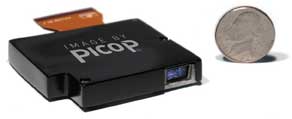
For manufacturers who want to bring the next generation of mobile devices to market, Microvision provides the PicoP display engine for high-volume embedded laser projection applications.
Courtesy of Microvision.
“So why are they only selling 500,000 units? The image quality
is not exciting for consumers,” said Mark Harward, CEO of Syndiant Inc., at
the DisplaySearch business conference during Display Week. “To go mass-market,
pico projectors must meet the consumer’s minimum performance threshold. The
product must ‘wow.’”
Dallas-based Syndiant says its VueG8, which uses the LCoS light
modulation process, benefits from its ability to use high-volume digital CMOS manufacturing
techniques to build hundreds of microdisplays on a single silicon wafer.
Syndiant announced at Projection Summit 2010 in Las Vegas in June
that it had developed a pico projector smaller than 4 cc with partners Foryou Multimedia
Electronics Co. Ltd. of Huizhou City, China, and Hong Kong’s Applied Science
and Technology Research Institute Co. Ltd. for embedding into handheld devices.
It is expected to ship before the end of this year.
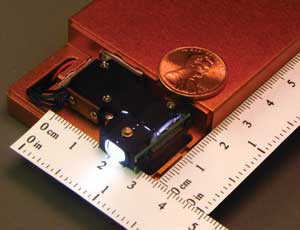
The smaller-than-4-cc pico projector engine developed by Hong Kong’s Applied Science and Technology Research Institute Co. Ltd. and Foryou Multimedia of China features Syndiant’s VueG8
technology. Courtesy of Business Wire.
DisplaySearch forecasts that the total pocket projector market
will reach 142 million units and $13.9 billion in revenue in 2018, with 45 million
units being stand-alone projectors and 97 million the embedded type.
The green laser market is expected to drive that growth. According
to Yole Développement sarl of Lyon, France, the green laser market is expected
to reach revenue of about $500 million by 2016 (see “Microprojectors spur development of green lasers,” Photonics Spectra, July 2010, p. 23).
“The next-generation synthetic green lasers are expected
to be more efficient and less expensive than their first-generation cousins,”
said Tiffany Bradford, an investor relations specialist at Microvision, in an early
August blog post on the company’s website.
“We also anticipate that the direct green lasers targeted
for introduction in the second half of next year may not reach desired performance
and cost targets immediately. For these reasons, we believe that synthetic lasers
could continue to remain a competitive alternative to direct green lasers for at
least the first four to five years after diodes are introduced,” she said.
Published: September 2010